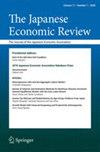日本的代际财富弹性
IF 1.5
4区 经济学
Q2 ECONOMICS
引用次数: 4
摘要
本研究利用日本原始调查数据估算了代际财富弹性,并评估了解释代际财富弹性的因素,如收入、教育水平、遗产和偏好。子女财富相对于父母财富的年龄调整弹性在0.266 ~ 0.367之间,过渡矩阵表明,财富的代际传递在分布的尾部更为强烈。父母与子女财富的相关性主要来源于收入、教育和遗产,三者共同构成财富弹性的63.9%。本文章由计算机程序翻译,如有差异,请以英文原文为准。
Intergenerational Wealth Elasticity in Japan
This study estimates the intergenerational wealth elasticity using original Japanese survey data and assesses factors explaining the intergenerational wealth elasticity, such as income, educational level, bequests and preferences. The age-adjusted elasticity of child wealth with respect to parental wealth ranges from 0.266 to 0.367, and transition matrices indicate that the intergenerational transmission of wealth persists more strongly in the tails of the distributions. The correlation between parent and child wealth mainly stems from income, education and bequests, which jointly constitute 63.9% of the wealth elasticity.
求助全文
通过发布文献求助,成功后即可免费获取论文全文。
去求助
来源期刊

Japanese Economic Review
ECONOMICS-
CiteScore
2.70
自引率
0.00%
发文量
15
期刊介绍:
Started in 1950 by a group of leading Japanese economists under the title The Economic Studies Quarterly, the journal became the official publication of the Japanese Economic Association in 1959. As its successor, The Japanese Economic Review has become the Japanese counterpart of The American Economic Review, publishing substantial economic analysis of the highest quality across the whole field of economics from researchers both within and outside Japan. It also welcomes innovative and thought-provoking contributions with strong relevance to real economic issues, whether political, theoretical or policy-oriented.
 求助内容:
求助内容: 应助结果提醒方式:
应助结果提醒方式:


